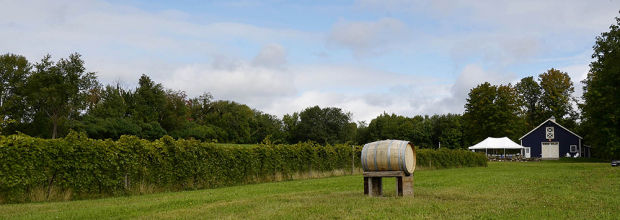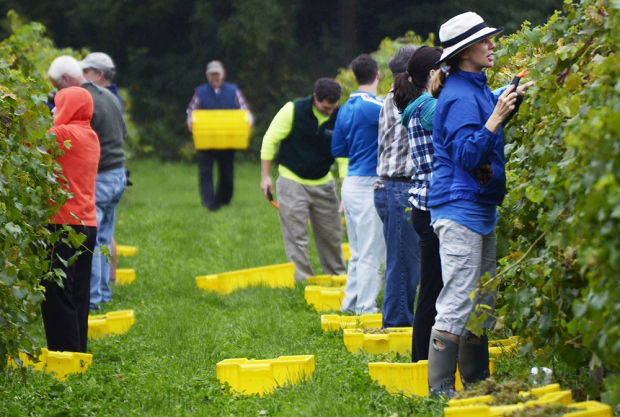First time
for everything: Across region, wineries begin grape harvest
Blue skies
greet pickers at Victory View Vineyards during the vineyard's grape harvest in
Easton Saturday, Sept. 14, 2013. (Ashleigh Abreu - Special to The Post-Star)
Oct 18, 2013 •
SCOTT DONNELLY -- sdonnelly@poststar.com
Victory View
Vineyard harvest
The region’s
growing winery industry has brought a relatively new crop to the fields of
Warren, Washington and Saratoga counties.
An area
better known for apples, corn and pumpkins is fast becoming a grape producer,
with new wineries adding more vines each year. It’s a trend enabled by science,
and Gerry Barnhart, co-owner of Victory View Vineyard, is among the first in
the region to go “all-in” on a bet the region can grow all the grapes needed to
support a winery.
“I would
expect we’ll get somewhere in the neighborhood of 12 tons of grapes this year,”
Barnhart said late last week, as he was getting set for a weekend of harvesting
at his winery on state Route 40 in Easton.
While
machines can be bought to harvest grapes, Victory View Vineyard’s grapes are
hand-harvested, Barnhart said. Friends, family and neighbors help with the
effort.
“At the end
of the harvest day, we put on a big meal and try to make it not just a work
session, but a good social event,” Barnhart said.
The work
requires pickers to move up and down both sides of the rows of vines, carefully
removing grapes and putting them in picking lugs, which hold about 30 pounds of
grapes each.
A tractor
towing a cart full of lugs takes the grapes to machines that crush them and
remove the stems. That starts a process that will result in several varieties
of bottled wine next year, Barnhart said.
This year’s
harvest is coming later than last year’s, he said.
“Last year,
we had just a phenomenal growing season and were able to harvest just about perfectly
ripe grapes the first week in September,” Barnhart said. “If you look at
long-term averages, this year is probably closer to normal.”
When it
comes to grapes for making wine, sugar content and acidity are the hallmarks of
a good crop. Barnhart said both are coming along well, despite a season marked
by strange weather.
Rainy
weather, like that experienced throughout the area in June, is a bigger concern
later in the grape-growing season.
“In 2011, we
had tropical storms Irene (August) and Lee (September) come through, and that
was pretty devastating on our harvest,” Barnhart said. “Grapes are like
tomatoes, in that they’ll soak up so much water they’ll break open. This year,
I think it’s going to be a very good year.”
June’s wet
weather did hurt at least one local winery.
Ken Denberg,
owner of Natural Selection Farm Winery in Cambridge, said June’s rain kept him
from protecting his vines from black rot, a fungal disease.
“I was not
able to keep up with my spray program,” Denberg said. “And the Marquette
variety ... seems to be susceptible to just about everything in the world that
you don’t want.”
The
Marquette grape, created by the University of Minnesota to be cold-weather
resistant, makes up about half the Natural Selection vineyard, Denberg said.
Other varieties did better, although he likely suffered a 50 to 60 percent crop
loss this year.
The rest of
his vines produced very well, and Denberg said he expects some good wines to
result. Natural Selection opened three years ago, and its vines range in age
from two to four years.
The
Marquette grapes did better at Victory View, although fungal disease management
took a lot of effort because of the weather, Barnhart said. His winery also has
LaCrescent, Frontenac, Lacrosse and Marechal Foch grape vines, all of which
were bred in laboratories to be cold-resistant.
For Tony
Oliva, owner of Oliva Vineyards on Route 4 south of Fort Edward, the bigger
issue was a Memorial Day weekend frost that destroyed the vulnerable blossoms
over much of his three-acre vineyard.
“We were
anticipating our best crop this year, and then we had the frost, and it
basically killed everything,” Oliva said.
Though Oliva
Vineyards is not an estate vineyard — the business buys crushed grapes from
growers in the Finger Lakes region — Oliva said he has plans to expand.
“Our goal
was always going to be 10 acres,” he said. “That is still our plan.”
Jim Tresize,
president of the New York Wine & Grape Foundation, said it’s common to see
large differences in grape crops over small areas. Though the “Minnesota
varieties,” as they’ve come to be called, are proving viable from the Thousand
Islands region to Lake Champlain, the impact of smaller weather events can be
profound.
For example,
in the Finger Lakes region, the lakes create a microclimate on the hills above
the water that’s suitable for many grape varieties.
“A lot of
times, even within a region like the Finger Lakes, the grape harvest can vary
from lake to lake,” Tresize said.
The
traditional grape harvest happens from early September to early October,
depending on the variety. And from here on out, dry, sunny days are what
wineries need, Tresize said.
Sunshine now
helps sugars in the fruit concentrate and avoids problems like grapes bursting
because of too much rain.
Statewide,
Tresize said he has heard varying reports about this year’s harvest, although
generally, it appears to be a good one.
“The next
month is going to be the key,” he said.
At Victory
View, the region’s only operating estate winery — meaning all its wine comes
from grapes grown at the vineyard — Barnhart expects to begin bottling wine
from this year’s crop in the late spring or early summer.
The winery’s
first vintage, available now, was the product of an acre of grapes of different
varieties harvested a year ago. Barnhart is looking to a bigger crop in coming
years, after another 180 vines of Frontenac were planted in May.
Victory
View, Natural Selection and Oliva are among the wineries that make up the Upper
Hudson Valley Wine Trail. More information is available at
upperhudsonvalleywinetrail.com.
Read more at:
http://poststar.com/news/local/first-time-for-everything-across-region-wineries-begin-grape-harvest/article_0dad422e-2016-11e3-9a84-001a4bcf887a.html




0 Comments:
Post a Comment
Subscribe to Post Comments [Atom]
<< Home